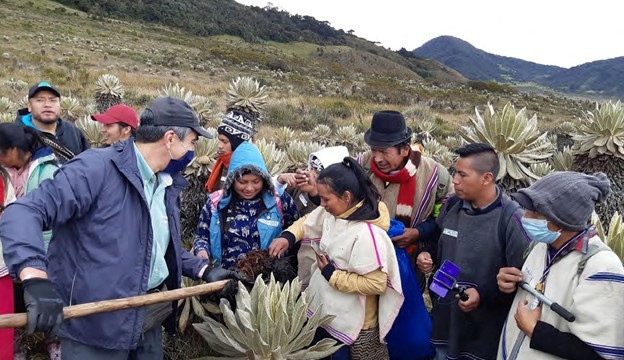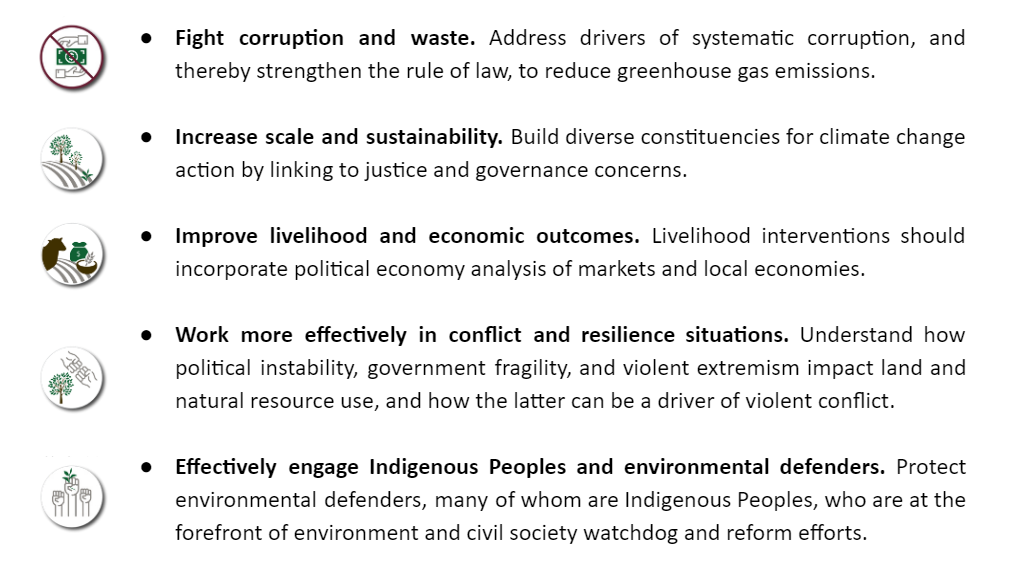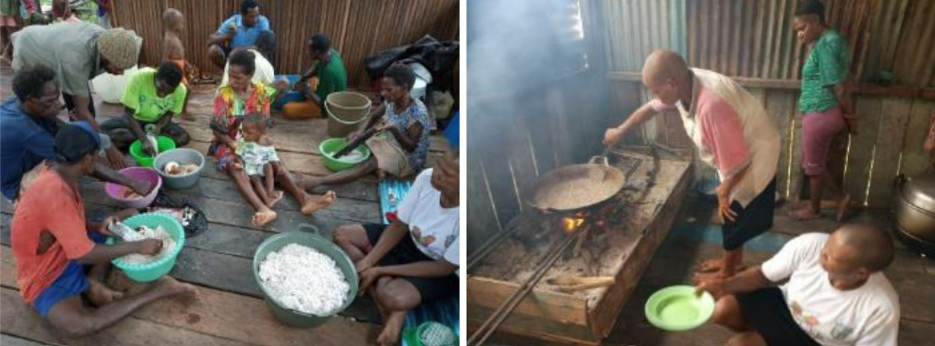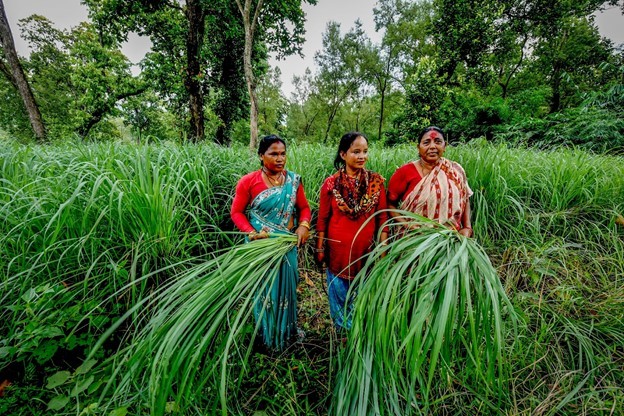|
There has been an intense focus by the U.S. government on international climate action in recent years. In January 2021, President Biden signed an executive order on tackling the climate crisis at home and abroad, and launched a suite of new initiatives at the United Nations Climate Change Conference (COP26) in November, including the Plan to Conserve Global Forests and the President’s Emergency Plan for Adaptation and Resilience (PREPARE). Then on Earth Day (April 22, 2022), USAID released our new Climate Strategy.
While climate work in USAID was frequently viewed as the responsibility primarily of its dedicated environment cadre, the new Climate Strategy clearly shows a shift in thinking, recognizing that climate change can only effectively be addressed by working in tandem with other development sectors. The cross-sectoral focus on climate change is perhaps nowhere more necessary than in the democracy, human rights, and governance (DRG) sector, and the benefits to achieving the Agency’s development objectives are mutually reinforcing: work in climate can help achieve DRG goals, and vice versa.
In addition, work on participatory natural resource management (PNRM)—while not solely focused on climate change—is frequently necessary to achieve both climate change and DRG objectives. This edition of the DRG Learning Digest outlines the connection between DRG, land-based mitigation to address climate change, and PNRM in USAID’s strategies and programs, and examines the following topics:
- First, it describes the new Climate Strategy and its relevance to DRG.
- It then summarizes three recent publications that can be used for cross-cutting work at the intersection of DRG, climate, and PNRM:
- A Cross-Sectoral Guide on Natural Climate Solutions (NCS, formerly Sustainable Landscapes) and DRG
- A Technical Note on Applied Political Economy Analysis to Inform NCS Investments
- An Evidence Review on PNRM and DRG
Please make use of DRG Evidence and Learning Team resources! (See text box at the end.)
New USAID Climate Strategy Emphasizes DRG
The new Climate Strategy strongly emphasizes governance, particularly through one of its nine intermediate results (IRs), IR 2.3: “Improve Governance: Strengthen responsive, transparent governance and citizen engagement for effective climate action.” This is an optimal example of DRG integration in a strategy from outside the DRG sector. Under this IR, USAID proactively supports citizen activism and civil society efforts, and strengthens participatory and inclusive governance systems to implement partner climate goals. Climate change and other environmental issues can frequently be a key strategic opportunity to connect with rural and urban constituencies, foster and develop prominent social movements, and support policy reform and legislative processes.
 In Colombia, scientists and Guambianos, the local Indigenous Peoples, discuss soil and carbon as part of the USAID-supported Páramos and Forests Activity, which helps the national government meet its landscape-based climate change mitigation goals and strengthens local economic development in 35 municipalities. Implementation includes participatory methods to determine land use, zoning, and natural resource management, and collaboration with communities and public- and private-sector actors to restore and protect ecosystems through mechanisms such as “payment for environmental services.” Photo: Santiago Jaramillo/USAID.
Many other IRs also have strong DRG equities:
- IR 1.3: “Mobilize Finance: Increase the flow of and equitable access to finance to support adaptation and mitigation.”
- IR 1.4: “Partner with Indigenous Peoples and Local Communities (IPLCs): Partner with IPLCs to lead climate action.”
- IR 1.5: “Amplify Crucial Voices: Enable and empower women and youth and other marginalized and/or under-represented groups to lead climate action.”
- IR 2.1: “Transform Key Systems: Advance transformation of key systems and essential services to reduce emissions and enhance climate resilience.”
- IR 2.4: “Work Across Assistance Types: Strengthen the coordination of humanitarian, development, and peacebuilding assistance to address climate impacts.”
As demonstrated by the strategy, a strong, interdependent relationship exists between citizen engagement, inclusive governance, equity, and climate action. Broad and diverse citizen engagement and good governance underpin both democratic resilience and climate resilience. On the one hand, the Climate Strategy underscores how DRG approaches—including citizen engagement, inclusivity, good governance, and political economy perspectives—are instrumental to achieving ambitious and transformational climate objectives. On the other hand, supporting climate action presents opportunities for the DRG sector to advance its goals. For example, climate change is a pressing challenge that frequently galvanizes public interest and opinions in many of the places we work. Focusing on climate change may also be a relatively “safe” topic of citizen engagement even in a more restrictive political space, especially if the host country government has made international climate commitments to which citizens can link their advocacy. Finally, supporting participatory, inclusive, and accountable climate action presents opportunities to broaden democratic networks and deepen democratic practices, processes, and institutions.
Climate change and environmental issues more broadly represent an important area to foster meaningful and inclusive citizen engagement, presenting opportunities to counter democratic backsliding and to advance democratic participation in important ways. Advancing climate and environmental goals, when they clearly meet DRG strategic objectives, can represent a significant win-win, by supporting democracy and utilizing DRG strategic approaches to provide a meaningful contribution to meet climate and environmental challenges. The strong cross-sectoral emphasis creates opportunities for DRG and environment officers to work together to advance joint DRG-climate objectives.
A variety of USAID publications are available that explore the connections between DRG, climate, and PNRM. The remaining sections explore three recent examples.
Achieving Both DRG and NCS Objectives
A cross-sectoral programming guide explores opportunities to integrate Natural Climate Solutions (NCS, formerly known as Sustainable Landscapes) and DRG work throughout the program cycle. Some of the modalities for integration are co-design and co-implementation, incorporating DRG tools and expertise, and natural resource governance. The guide analyzes case studies from Nepal, Cambodia, and West Africa. Some of the general benefits to both sectors of cross-sectoral work include:
 Specific benefits from the lens of each collaborating sector are:
DRG Benefits: Strengthening land-based climate mitigation can support DRG objectives since natural resource management (NRM) is a tangible type of public service delivery of particular relevance to local communities. Focusing on this sector offers a concrete means of advancing democratic governance. NRM is often an area around which there is common understanding for communities to come together to work collectively and overcome social divides and political polarization. This can encourage democratic outcomes such as increased civic participation and government oversight as well as more transparent, responsive, and participatory forms of government.
NCS Benefits: Focusing on DRG approaches and principles—such as increasing community participation, strengthening local governance, addressing land tenure, and achieving buy-in from communities that are meaningfully involved—can promote more sustainable results, for example to help sequester carbon for longer periods of time. This increased permanence of interventions is particularly relevant for NCS activities to avoid certain scenarios, such as when communities protect trees for the life of an activity and then cut them down once it concludes. At a higher level, working with and strengthening local institutions may also improve the scale and impact of policy or planning work necessary for more sustainable and systemic outcomes.
Applied Political Economy Analysis (PEA) Can Inform USAID’s NCS Investments
Applied PEA can help Missions gain deeper insight into the contextual barriers and opportunities facing NCS activities. A recent technical note describes in detail why NCS teams should do PEA and what they would learn.
A natural first question is, why do a PEA? Applied PEA research investigates the root causes of current arrangements of power and decision-making, resulting in a better shared understanding of the dynamics that may enable or hinder NCS investments, as well as the key systems actors who could play a role in supporting positive change. NCS programming may then engage more effectively either to navigate political risks, or even aim to fundamentally transform these dynamics.
What are the PEA elements and how do they relate to NCS? Gaining an understanding of arrangements of power and decision-making is based on the four PEA elements. The following describes those four elements and how they relate directly to NCS.
-
Foundational factors: Regime types and governance systems influence the quality of forest management. Historical agreements (often dating from the colonial period) that granted resource rights to agriculture, ranching, timber, and/or mining companies incentivized tropical deforestation and degradation, with implications for current land use patterns. Major economic drivers of deforestation include large-scale production of high-demand commodities such as beef, palm oil, and soy.
-
Rules of the game: National and local governments play an important role in recognizing and enforcing communal tenure. Lack of formal land tenure is a major barrier faced by many Indigenous Peoples and local communities (IPLCs). However, enshrining customary tenure and communal governance does not guarantee better forest management. IPLCs’ forest governance regulations and policies are often not codified in law or necessarily recognized by the government, leaving community forest management vulnerable to outside actors. The more jurisdictions involved with forest governance, the more likely deforestation becomes. Sustainable forest governance requires a shift in incentive structures and ensuring that key actors’ interests align. While these trends in improved governance can be promising, there is often pushback from entrenched interests.
-
Here and now: Locally-led initiatives have the potential for reducing deforestation. Recent international initiatives also provide the opportunity to advance NCS at the local and national levels.
-
Dynamics: There are few instances where positive incentives align among stakeholders at community, local, and national levels to manage tropical forests sustainably and equitably. Nonetheless, there is growing consensus among key actors that IPLCs are often the best and most cost-effective stewards of tropical forests to maintain and increase carbon storage. Forest certification is an important factor in engaging private interests in forest governance.
 Community members develop local coconut oil-based products as part of the LESTARI activity in Yepem Village, Papua Province, Indonesia. The initiative focused on the development of sustainable small-scale businesses, supporting the improvement of local livelihoods and strengthening efforts for sustainable natural resource management. Among other impacts, the governance elements of the initiative supported Forest Protection Group patrols to actively protect the forest and contribute significantly to forest and biodiversity conservation. Photo: USAID/LESTARI.
LESTARI (2015-2020) is one prominent example of a USAID NCS activity that used PEA. It supported the Government of Indonesia’s efforts to reduce greenhouse gas emissions and conserve biodiversity in carbon-rich and biologically significant forest and mangrove ecosystems. The program focused on effective forest and land use governance, as well as building constituencies for advocacy within local communities. LESTARI commissioned a PEA after a midterm “pause and reflect” session that identified gaps in their understanding of the political economic context. For instance, the PEA revealed that formal policies that were aimed to reduce the impact of commodity production could be undercut by “rules of the game” such as informal or illegal land deals facilitated by government officials. As a result, LESTARI engaged citizen groups to improve their knowledge and capacity to pressure government officials through social accountability mechanisms rather than focusing on government capacity-building. For example, the PEA identified opportunities to support citizen-led processes to address bottlenecks and advocate for the Papua provincial government to put in place a spatial planning management information system and a database for transparent information exchanges. The result is an online system that prevents land use permits from being issued in protected areas or overlapping other permits.
PNRM and DRG: Key Programmatic Considerations
USAID has long realized that empowering local communities to directly manage their natural resources in collective and participatory ways can lead to tangible conservation and other development outcomes. The urgency of bolstering the world's land-based climate change solutions heightens the relevance for PNRM approaches to encourage stronger democratic decision-making and dispute resolution, which is necessary to achieve increased carbon sequestration in a sustainable, equitable, and just manner.
A systematic evidence review explores the question: under what conditions has PNRM been linked, positively or negatively, to democratic outcomes? The review identified the following enabling conditions for PNRM linkages to positive democratic outcomes:
- Early organizational support from local nongovernmental organizations (NGOs) (or government agencies) to develop and/or strengthen communities’ internal capacities for collective action.
- A bridging role by local NGOs (or government agencies) to bring together actors from formal and customary institutions and other stakeholders to engage in dialogue and problem-solving.
- Recognition by government authorities and partners that it is in their political and institutional interests to work collaboratively with communities to solve NRM problems.
- Alliances among communities and/or with regional and national environmental organizations for advocacy and mobilization around environmental (and non-environmental) issues of shared concern.
- Political windows of opportunity that increase the political space for PNRM, including legal reforms that empower local communities, or political parties that come to power based on grassroots support.
- Progressive increases of social capital (often building on pre-existing social capital), with expanding social networks and diversification of government relationships.
One of the strongest examples of PNRM making a meaningful contribution to democratic outcomes is the development of community forestry in Nepal. Since the 1970s, community forestry in Nepal has contributed to and reflected waves of reform in development strategy, from technical management approaches and participatory forestry to sustainable forestry aimed at addressing global climate change. As community forest user groups (CFUGs) grew in number, a national network, the Federation of Community Forestry Users Nepal (FECOFUN) was created in the mid-1990s. FECOFUN became a key player in forest sector politics as a “secondary-level organization,” pooling the shared interests of communities through street protests and lobbying campaigns. Eventually, the group became an influential force in national policy debates, interacting with governance at all levels. During Nepal’s years of political crisis from 1996-2006, CFUGs provided political stability by filling the vacuum left in the absence of elected local governments. CFUGs have also added to momentum for increased local participation for women, Indigenous Peoples, and marginalized groups.
 Nepal’s USAID-supported Hariyo Ban program helped build resilience to climate change in communities and ecosystems by restoring and conserving forests, while significantly impacting the participation of citizens in government. Much of this success was due to the greatly expanded voice and impact of community forestry at the country level. Many conservationists have run for office and become part of the government—during local elections in 2017, 776 were elected to government positions, 32 percent of them women. Photo: Chandra Shekhar Karki/CIFOR/Hariyo Ban.
At the same time PNRM is fundamentally a form of decentralized governance and faces similar challenges practitioners have observed in promoting decentralization and advancing local governance. The review identified eight constraining factors to PNRM that can prevent it from contributing to democratic outcomes:
- Decentralization of NRM by central government authorities is incomplete or flawed, with key powers of decision-making retained by elite decision-makers and government agencies.
- Decentralization of NRM is motivated by the preferences of donors and other external actors, with local elites seeking to benefit from political support, patronage, and rent-seeking opportunities.
- Obligations for NRM implementation are transferred to local communities without the proportionate transfer of necessary resources, while elites control key decision-making.
- New governance arrangements under decentralization create “new institutional elites,” who are upwardly accountable to higher level government, but not downwardly accountable to local communities.
- As a form of resistance to the new distribution of power, dominant political actors reassert their power in new institutional niches at different scales.
- Patriarchal gender norms in local communities limit women’s participation, voice, and decision-making.
- Sociocultural norms limit participation, voice, and decision-making, especially for marginalized populations.
- External actors supporting international environmental initiatives fail to take into account national political dynamics and the complexity of local communities.
Need Further Assistance?
If you are interested in DRG-environment cross-sectoral work, please contact the DRG Center’s Policy, Coordination, and Integration (PCI) Team at ddi.drg.pci@usaid.gov.
Welcome to the DRG Learning Digest, a newsletter to keep you informed of the latest learning, evaluation, and research in the Democracy, Human Rights, and Governance (DRG) sector. Views expressed in the external (non-USAID) publications linked in this Digest do not necessarily represent the views of the United States Agency for International Development or the United States Government.
Don't forget to check out our DRG Learning Menu of Services! (Link only accessible to USAID personnel.) The Menu provides information on the learning products and services the Evidence and Learning Team offers to help you fulfill your DRG learning needs. We want to help you adopt learning approaches that emphasize best fit and quality.
The Evidence and Learning Team is also excited to share our DRG Learning, Evidence, and Analysis Platform (LEAP) with you. This Platform contains inventories of programmatic approaches and indicators, evidence gap maps, and data portraits—all of which can be very useful in DRG activity design, implementation, evaluation, and adaptation. Some of these resources are still being built, so check back frequently to see what has been newly added.
We also want to share our DRG Learning Harvest with you! (Link only accessible to USAID personnel.) This is a searchable database of DRG learning products, including summaries of key findings and recommendations, drop-down menus to easily find documents related to a particular country or program area, and links to the full reports on the DEC.
Our friends at the Varieties of Democracy (V-Dem) Institute are also seeking to expand their research partnership with USAID on the complex nature of democracy by inviting research questions from you for V-Dem to work on. If there's a DRG technical question you've been wondering about, please email the Evidence and Learning Team at ddi.drg.elmaillist@usaid.gov.
We welcome your feedback on this newsletter and on our efforts to promote the accessibility, dissemination, and utilization of DRG evidence and research. Please visit the DRG Center's website for additional information or contact us at ddi.drg.elmaillist@usaid.gov.
|